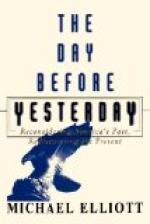Mr. Vieweg senior invited me to shoot with him on several occasions during the winter months. The “Kettle-drive” (Kessel-Treib) is the local manner of shooting hares. Guns and beaters form themselves into an immense circle, a mile in diameter, over the treeless, hedgeless flats, and all advance slowly towards the centre of the circle. At first, it is perfectly safe to fire into the circle, but as it diminishes in size, a horn is sounded, the guns face round, back to back, and as the beaters advance alone, hares are only killed as they run out of the ring. Hares are very plentiful in North Germany, and “Kettle-drives” usually resulted in a bag of from thirty to forty of them. To my surprise, in the patches of oak-scrub on the moor-lands, there were usually some woodcock, a bird which I had hitherto associated only with Ireland. Young Vieweg was an excellent shot; in common with all his father’s other guests, he was arrayed in high boots, and in one of those grey-green suits faced with dark green, dear to the heart of the German sportsman. The guns all looked like the chorus in the Freischutz, and I expected them to break at any moment into the “Huntsmen’s Chorus.” Young Vieweg was greatly pained at my unorthodox costume, for I wore ordinary homespun knickerbockers, and sported neither a green Tyrolese hat with a blackcock’s tail in it, nor high boots; my gun had no green sling attached to it, nor did I carry a game-bag covered with green tassels, all of which, it appeared, were absolutely essential concomitants to a Jagd-Partie.
In these country districts round Brunswick nothing but Low German ("Platt-Deutsch”) was talked. Low German is curiously like English at times. The sentence, “the water is deep,” is identical in both tongues. “Mudder,” “brudder,” and “sister” have all a familiar ring about them, too. The word “watershed,” as applied to the ridge separating two river systems, had always puzzled me. In High German it is “Wasser-scheide,” i.e. water-parting; in Low German it is “Water-shed,” with the same meaning, thus making our own term perfectly clear. “Low” German, of course, only means the dialect spoken in the low-lying North German plains: “High” German, the language spoken in the hilly country south of the Harz Mountains. High German only became the literary language of the country owing to Luther having deliberately chosen that dialect for the translation of the Bible. The Nibelungen-Lied and the poems of the twelfth and thirteenth centuries were all in Middle-High German (Mittel-Hoch Deutsch).
I remember being told as a boy, when standing on the terrace of Windsor Castle, that in a straight line due east of us there was no such corresponding an elevation until the Ural Mountains were reached, on the boundary between Europe and Asia. This will give some idea of the extreme flatness of Northern Europe, for the terrace at Windsor can hardly be called a commanding eminence.




